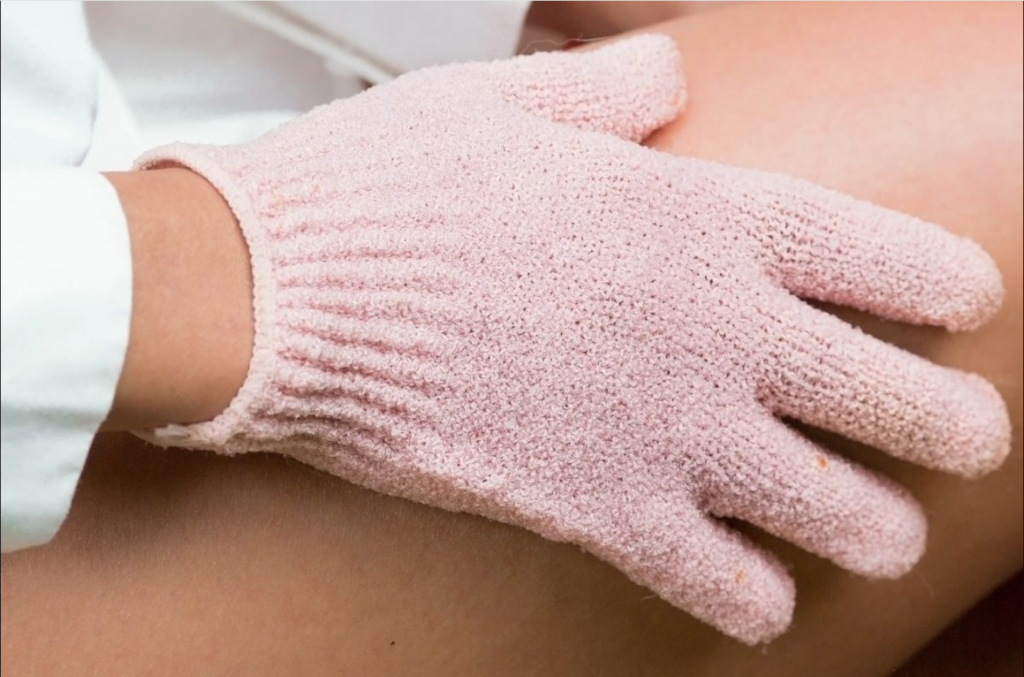If you’ve been looking for a way to take your skincare routine to the next level, you’ve likely heard of exfoliating gloves. These handy beauty tools have gained popularity for their effectiveness in sloughing away dead skin, leaving skin feeling soft, refreshed, and glowing. But what exactly is an exfoliating glove, and how does it work?
What Is an Exfoliating Glove?
An exfoliating glove is a mitt that fits over your hand, typically made from textured fabric or natural fibers. It’s designed to exfoliate the skin by scrubbing away dead skin cells and impurities that build up on the skin’s surface. These gloves come in various materials—some are more gentle, while others are made for deep exfoliation. They’re reusable, easy to clean, and come in many textures to suit different skin types and needs.
How Does an Exfoliating Glove Work?
The glove’s texture gently scrubs away the outermost layer of skin, revealing fresher, smoother skin underneath. By physically removing dead cells, the glove helps to:
- Smooth Rough Skin: Exfoliating gloves can help soften rough patches on areas like elbows, knees, and heels.
- Prevent Ingrown Hairs: Regular exfoliation can reduce the likelihood of ingrown hairs, making it an excellent prep tool before shaving or waxing.
- Improve Product Absorption: Exfoliated skin absorbs skincare products more effectively, allowing serums, lotions, and oils to penetrate deeper for maximum benefit.
- Boost Circulation: The scrubbing motion also stimulates blood flow, adding a natural, healthy glow to your skin.
How to Use an Exfoliating Glove
Using an exfoliating glove is simple, but a few steps can help you get the most out of it:
- Prep Your Skin: Start with damp skin. Showering or bathing first helps soften the skin and opens pores, making it easier to exfoliate.
- Apply Cleanser or Body Wash: Apply a gentle cleanser to your skin or directly onto the glove. Avoid harsh products or scrubs with beads, as they can be too abrasive when paired with the glove.
- Start Scrubbing Gently: Using gentle, circular motions, massage your skin with the glove. Start with less pressure, especially if you’re new to exfoliating or have sensitive skin.
- Focus on Rougher Areas: Areas like elbows, knees, and feet often need more attention, but be careful around sensitive spots like the face or neck. For your face, consider using a glove with a softer texture.
- Rinse and Moisturize: Once done, rinse your skin thoroughly to remove any dead cells, then apply a moisturizer to keep your skin hydrated.
- Clean Your Glove: After each use, rinse the glove and hang it up to dry. Washing it regularly will keep it fresh and bacteria-free.
When to Use an Exfoliating Glove
Most people can benefit from exfoliating once or twice a week, but those with sensitive skin may want to limit it to once a week or less. Over-exfoliating can lead to irritation or damage, so adjust your frequency based on your skin’s needs and reactions.
Choosing the Right Exfoliating Glove
With various options on the market, choosing a glove that fits your skin type and exfoliation goals is essential. For a more gentle exfoliation, go for a softer fabric like a microfiber glove. If you want a deeper exfoliation, look for gloves with a rougher texture.
Is an Exfoliating Glove Worth It?
An exfoliating glove can be a game-changer in any skincare routine. It’s a versatile tool for maintaining smooth, soft skin, from boosting your skin’s natural glow to helping prevent ingrown hairs. Just remember to start gently and find a routine that works for you—your skin will thank you!

